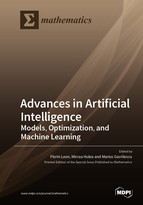Advances in Artificial Intelligence: Models, Optimization, and Machine Learning
A special issue of Mathematics (ISSN 2227-7390). This special issue belongs to the section "Mathematics and Computer Science".
Deadline for manuscript submissions: closed (16 March 2022) | Viewed by 56968
Special Issue Editors
Interests: artificial intelligence; machine learning; multiagent systems; software design
Special Issues, Collections and Topics in MDPI journals
Interests: spiking neural networks; artificial intelligence; embedded systems; optical wireless communication
Special Issues, Collections and Topics in MDPI journals
Interests: machine learning; computer graphics; data analytics; gaming engines; physics simulations
Special Issues, Collections and Topics in MDPI journals
Special Issue Information
Dear Colleagues,
Nowadays, artificial intelligence is an integral part of scientific progress. Various methods have been used to solve problems that were considered to be challenging until now. AI has the potential to offer tools for learning, knowledge discovery, and decision making that can outperform human abilities and can be used in a large number of application domains.
This Special Issue will focus on recent theoretical and computational studies of artificial intelligence, with a focus on models, optimization, and machine learning. Topics include, but are not limited to, the following:
- Deep learning and classic machine learning algorithms
- Neural modelling, architectures, and learning algorithms
- Neuro-symbolic models and explainable artificial intelligence models
- Spiking neural networks: theory and applications
- Hebbian learning and other biologically plausible neural models
- Optical neural networks
- Biologically-inspired optimization algorithms
- Algorithms for autonomous driving
- Reinforcement learning and deep reinforcement learning
- Probabilistic models and Bayesian reasoning
- Adaptive systems
- Intelligent agents and multiagent systems
Prof. Dr. Florin Leon
Dr. Mircea Hulea
Dr. Marius Gavrilescu
Guest Editors
Manuscript Submission Information
Manuscripts should be submitted online at www.mdpi.com by registering and logging in to this website. Once you are registered, click here to go to the submission form. Manuscripts can be submitted until the deadline. All submissions that pass pre-check are peer-reviewed. Accepted papers will be published continuously in the journal (as soon as accepted) and will be listed together on the special issue website. Research articles, review articles as well as short communications are invited. For planned papers, a title and short abstract (about 100 words) can be sent to the Editorial Office for announcement on this website.
Submitted manuscripts should not have been published previously, nor be under consideration for publication elsewhere (except conference proceedings papers). All manuscripts are thoroughly refereed through a single-blind peer-review process. A guide for authors and other relevant information for submission of manuscripts is available on the Instructions for Authors page. Mathematics is an international peer-reviewed open access semimonthly journal published by MDPI.
Please visit the Instructions for Authors page before submitting a manuscript. The Article Processing Charge (APC) for publication in this open access journal is 2600 CHF (Swiss Francs). Submitted papers should be well formatted and use good English. Authors may use MDPI's English editing service prior to publication or during author revisions.
Keywords
- Neural networks
- Deep learning
- Machine learning
- Optimization algorithms
- Autonomous driving
- Bayesian networks
- Reinforcement learning
- Multiagent systems








